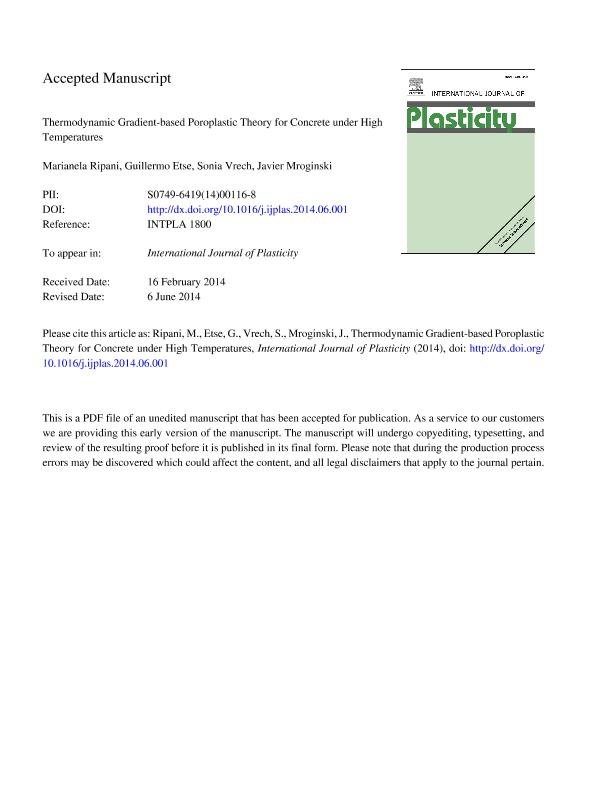Mostrar el registro sencillo del ítem
dc.contributor.author
Ripani, Marianela

dc.contributor.author
Etse, Jose Guillermo

dc.contributor.author
Vrech, Sonia Mariel

dc.contributor.author
Mroginski, Javier Luis

dc.date.available
2017-02-14T21:36:20Z
dc.date.issued
2014-10
dc.identifier.citation
Ripani, Marianela; Etse, Jose Guillermo; Vrech, Sonia Mariel; Mroginski, Javier Luis; Thermodynamic gradient-based poroplastic theory for concrete under high temperatures; Elsevier; International Journal Of Plasticity; 61; 10-2014; 157-177
dc.identifier.issn
0749-6419
dc.identifier.uri
http://hdl.handle.net/11336/13027
dc.description.abstract
Concrete materials subjected to long term exposures to high temperatures suffer severe degradations in its mechanical properties (cohesion, friction, strength and stiffness) and changes in their failure mechanisms. These degradations may lead to irreversible damage or sudden collapse of the related structures. From the predictive analysis stand point, accurate constitutive theories are required to simulate the variations of concrete mechanical failure behavior under high and durable temperature fields. In the realm of the smeared crack approach, non-local model strategies are required to objectively reproduce failure behaviors under coupled thermo-mechanical loading conditions, while realistic descriptions of the involved characteristic lengths are needed to objectively reproduce the variation from ductile to brittle failure modes depending on the acting confining pressure and temperature. In this work, a thermodynamically consistent gradient poroplastic model for concrete subjected to high temperatures is proposed. A particular and simple form of gradient-based poroplasticity is considered whereby the state variables are the only ones of non-local character. The degradations of these variables due to coupled thermo-mechanical effects are described in the framework of the thermodynamic approach. After describing the material formulation, numerical analyses are presented which demonstrate the predictive capabilities of the proposed constitutive theory for different stress paths and thermal conditions.
dc.format
application/pdf
dc.language.iso
eng
dc.publisher
Elsevier

dc.rights
info:eu-repo/semantics/openAccess
dc.rights.uri
https://creativecommons.org/licenses/by-nc-nd/2.5/ar/
dc.subject
Concrete
dc.subject
Gradient Theory
dc.subject
Thermodynamic Consistency
dc.subject
High Temperature
dc.subject
Failure Behavior
dc.subject.classification
Ingeniería Civil

dc.subject.classification
Ingeniería Civil

dc.subject.classification
INGENIERÍAS Y TECNOLOGÍAS

dc.title
Thermodynamic gradient-based poroplastic theory for concrete under high temperatures
dc.type
info:eu-repo/semantics/article
dc.type
info:ar-repo/semantics/artículo
dc.type
info:eu-repo/semantics/publishedVersion
dc.date.updated
2017-02-13T20:30:43Z
dc.journal.volume
61
dc.journal.pagination
157-177
dc.journal.pais
Países Bajos

dc.journal.ciudad
Amsterdam
dc.description.fil
Fil: Ripani, Marianela. Universidad de Buenos Aires. Facultad de Ingenieria. Departamento de Construcciones y Estructuras. Laboratorio de Materiales y Estructuras; Argentina. Consejo Nacional de Investigaciones Científicas y Técnicas; Argentina
dc.description.fil
Fil: Etse, Jose Guillermo. Universidad de Buenos Aires. Facultad de Ingenieria. Departamento de Construcciones y Estructuras. Laboratorio de Materiales y Estructuras; Argentina. Consejo Nacional de Investigaciones Científicas y Técnicas; Argentina
dc.description.fil
Fil: Vrech, Sonia Mariel. Universidad de Buenos Aires. Facultad de Ingenieria. Laboratorio de Metodos Numericos En Ingenieria; Argentina. Consejo Nacional de Investigaciones Científicas y Técnicas; Argentina
dc.description.fil
Fil: Mroginski, Javier Luis. Universidad de Buenos Aires. Facultad de Ingenieria. Laboratorio de Metodos Numericos En Ingenieria; Argentina. Consejo Nacional de Investigaciones Científicas y Técnicas; Argentina
dc.journal.title
International Journal Of Plasticity

dc.relation.alternativeid
info:eu-repo/semantics/altIdentifier/url/http://dx.doi.org/10.1016/j.ijplas.2014.06.001
dc.relation.alternativeid
info:eu-repo/semantics/altIdentifier/url/http://www.sciencedirect.com/science/article/pii/S0749641914001168
Archivos asociados
